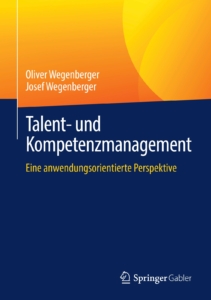Talent and competence management must be an integral part of the integrated management system and aims to make a significant contribution to achieving the company's goals, thereby ensuring the organization's performance.
The core objectives can be described in simplified terms as
- the "right" people
- in the "right" place
- at the "right" time
- in the "right" quantity
The interaction between corporate management, executives, human potential management and team members is a relevant variable for success. Over the years, role models have changed and shifted. For example, the role of the team member in talent and competence management has become more important.
Management | Leadership
The goal of every organization is to ensure its own long-term performance. Management means creating the framework conditions so that existing and future employees [can] use their competencies on their own responsibility for the success of the organization. The goal of management is to do the right thing right [effectiveness and efficiency].
- Ensuring a goal-oriented corporate culture that is in line with the strategy
- Ensure a values-based leadership and management culture that supports the vision and mission
- Provision of adequate working models
- Motivating wage, salary and recognition systems
- Support in and provision of tools and systems to find, select, integrate and develop talents
Human Potential Management
Human Potential Management" has its roots in Humanistic Psychology. Its representatives, Carl R. Rogers, Abraham H. Maslow, Victor E. Frankl and many others have coined the idea that in all people there is hidden potential which can be awakened through purposeful development. Abraham H. Maslow (1954, 1962) and Carl R. Rogers (1951, 1973) describe that by "raising and developing this potential" the desire for meaning and quality of life is fulfilled.
Basically, it is a holistic approach, which is also of central importance in Human Potential Management. Human Potential Management [HPM] focuses on the "potential" and the "competencies" of employees and managers.
Human Potential Management, with its sub-areas "Talent and Competence Management" and "Human Resources Management", is part of this integral management system and aims to make a significant contribution to the achievement of corporate objectives and thus to ensure the organization's performance.
- Development and implementation of a company-specific competence system as the basis of competence-based talent and competence management
- Talent Marketing | Talent Search | Talent Selection
- Onboarding, integration of "new" employees
- Targeted competence development, based on the results of accurate competence diagnostics
- Create framework conditions so that employees and managers can deliver the best possible performance
- Human Capital Management
- Support of change and transformation processes
Team members
Changing the role and tasks of team members over time is central to talent and competency management. The role of team members can be defined as either a processor or [in the organization] a collaborator. But what has been required for some time is entrepreneurial thinking and action at all levels. We can therefore also understand the role of team members as co-thinkers or co-entrepreneurs - intrapreneurship.
Intrapreneurship means "entrepreneurship within the company. It refers to the entrepreneurial and responsible thinking and acting of employees. To this end, it is necessary to create an environment in which this empowerment of employees is made possible. This requires an increase in self-responsibility as well as self-determination and an expansion of the scope for action.
If we think one step further and the trend goes in the direction of "virtual organizations" [network of independent companies], partnerships, cooperations and collaboration of independent experts within the framework of projects, then employees actually become entrepreneurs in the true sense of the word.
These changes in the image of team members have significant implications for the role in talent and competence management.
- Employees take a much more active role and assume responsibility for their own career and skills development
- They design their personal, individually defined competence development, in coordination with their manager
More functions
"New" organizational forms, such as ITIL, SCRUM, TQM, etc. define additional roles that have an influence on talent and competence management or take over tasks of the same.
If several organizational forms or management systems exist in the company and are not aligned with each other, this can lead to irritations. This means that the systems must be brought together to form a holistic, integrated management system.
The goals, tasks and tools used by the functions overlap significantly with talent and competency management. If not coordinated and aligned, this would lead to duplication in the organization and demotivation among employees. A comprehensive competency model and the function descriptions based on it, as part of talent and competency management, are a viable solution approach to this.
Excerpt from Wegenberger/Wegenberger: Talent and Competence Management, Springer 2021
Tip
The world of talent and competence management in a clear and application-oriented form can be found in the book of the same name.




